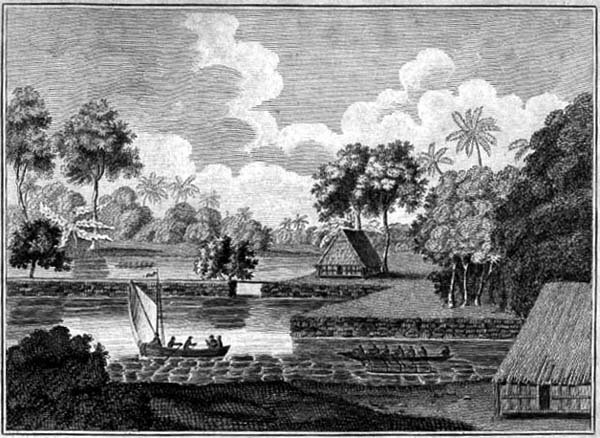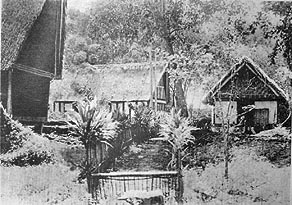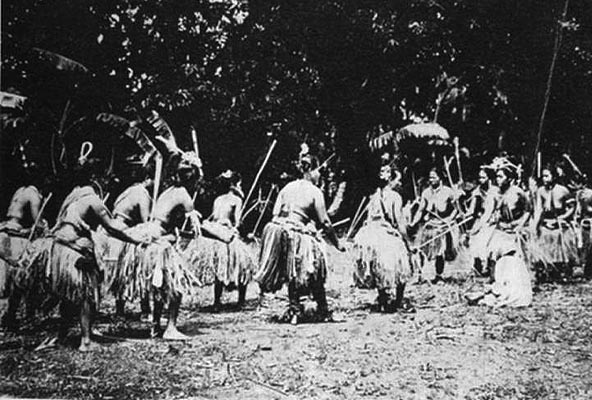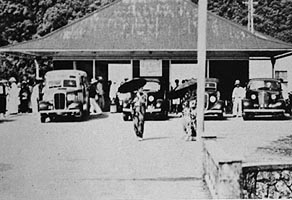 |
 |
 |
 |
||||
|
|
|
|
|
|
|
|
|
|
|
|||||||
| |
|
|
|
|
“Around Captain Wilson’s time, 1778, there were about 20,000 to 30,000 Palauans,” Kathy tells us. “And we say that because of the stone work that’s in the villages. The whole village is laid out in stones—they are still in evidence right now. In Airai Village, you see the bai, there are stone walkways up to it. And that’s the work of a lot of people. There weren’t that many tools then, so this stonework [see drawing, above] represents a lot of energy, a lot of young people doing that."
|
||
|
|
||
| “There are quite a few abandoned villages,” Tina adds, “and this Palau Compact Road they are building in Babeldaob really shows that: there are villages still very much intact, with stone pathways and platforms.” Kathy explains how land and title were managed in these traditional villages: “Anthropologically, it is a matrilineal society, which means tracing your decent through the female line. Tracing their decent, every Palauan belongs to their mother’s clan. That’s where you say your roots are. You’re beginning is through your mother’s line. And from there, you get land, you get titles, you get power and authority."
|
|
|
|
|
“Status in the community is based on your female line and the ranking of the clan that your mother is in or belonged to. The same holds true with the father, except that in the final analysis—the final analysis is when you die—where do they place you? Where do you go? You get buried, or you go, to your mother’s home place. That’s the idea. You can also inherit land and title and position from your father, but your mother is the roots. “There are ten clans standard, generally. Some villages may have eleven, but in old Palau there is ten clans in each state, each hamlet, and they’re ranked one to ten. Clans are there for exchanging services. They are more than simply economic."
|
||
|
|
||
|
“Before, when we had only a certain number of stone money, it’s not like if you don’t have enough reserve, you print some more and you get more. You could say that the Palauan stone money—the real ones—are finite. There’s only so much of it, no more, no less. And they circulate among the people, the clans, and they’re used for the different customary functions we have: building a house, a child birth ceremony, settlement of divorces, settlement for death and so forth."
|
||
|
|
||
“It’s possible that one piece would be used for a death settlement in this occasion and then given to a clan and they use it for other functions and so forth. So one piece of Palauan stone money can circulate among the community like that. "It’s ranked according to the value, and the value of the money is based on the size and the color. But also the value is dependent on the type of transaction that it was used for." “But most of the services were exchanged. You help me by bringing in some taro because you’re my brother, your wife and then these accumulate over time and then a piece of stone money is given to pay off the services and it’s up to you, it’s up to your wife because the women are the ones who provided the services, and the husband pays for the services."
|
|
|
“It’s not a caste system. However, in customary functions and ceremonies there are distinct rankings or distinct places, and distinct activities that are only relegated to a particular plan or a particular group of people in a community. This will raise respect. "There is always recognition of the high clan. But in everyday socializing, you can sit together, you can eat together. But there’s always this knowledge that that’s the high clan, so certain provisions or certain activities or certain actions are done to show the rank or their position in the community. But everyday, they really live in the same houses as you do, they eat the same food and so forth."
|
|
|
|
“After Captain Wilson’s time, the population here was gradually decimated because of diseases introduced by traders and whalers. And then it grew a little bit, but during the Spanish, German and Japanese era, the population started to decline because of measles and other diseases. After WWII, there was 5,000 Palauans."
|
||
|
|
||
“There has been depopulation," Tina agrees, "and the moving of people to centers of population. But communities were altered during contact period, especially during the German and Japanese era here. With the introduction of wage labor, that shifted people, moving every able-bodied man to work. And of course then when you move the able-bodied men and women away from village, then nobody is there to maintain the paths and streams and the taro patches, and maintain the bai. "There were maybe about 30,000, 40,000 Japanese and about 5,000 Palauans by the end of the war," Johnson adds. "If not for World War II, this would be a Japanese island."
|
|
|
|
|
|
Such changes of population is one impact seen in the aftermath of the arrival of the Japanese in Palau.
|
||
|
|
||
|
|
|
|
|
|

|
| Airai Home | Map Library | Site Map | Pacific Worlds Home |
|
|
|
|

|
|
|
|||
| Copyright 2003 Pacific Worlds & Associates • Usage Policy • Webmaster |
|||







